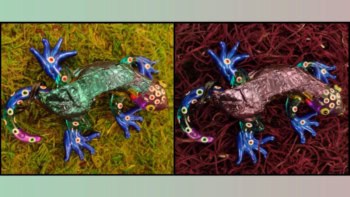Physicists have found a new way to amplify light that could make lasers more efficient. Chris Phillips at Imperial College in London and colleagues at the University of Neuchâtel in Switzerland made the breakthrough using specially patterned nanocrystals that behave as artificial atoms. Because the separation between energy levels in their crystals can be controlled, laser light can be produced without the need for a population inversion. The technique could also find applications in optical data storage and even allow materials to become completely transparent (Nature Materials 5 175).
The active medium in a laser is usually a gas or a crystal in which the atoms have been excited or “pumped” so that more electrons exist in the upper of two energy levels. Once such a population inversion has been achieved, a beam of light passing through the medium can stimulate electrons to fall into the lower energy level and emit a photon of the same wavelength. The emitted photons then go on to de-excite further atoms, amplifying the original beam. Phillips and co-workers have now shown that if the quantum phases of the electron waves in these two levels are coupled together, using a light pulse, then light can be emitted from the system without the need for population inversion. Although the conditions needed to observe this effect have been produced in gases, they have never been seen in a solid until now.
The UK-Switzerland team made a layered semiconductor nanostructure from indium gallium arsenide and aluminium indium arsenide. The structure contains three energy levels, and their energies and separations can be controlled by altering the thicknesses and compositions of the ultra-thin semiconductor layers that make up these “artificial atoms”. Electrons from the ground state can either jump directly to level two, or go up to level three and come back down again to level two. The electrons behave in a wave-like way and the researchers found a way of controlling, with a laser, the phases of the quantum waves that represent these two processes, so that they interfere with each other. Under these “coherent” conditions they found that the system emitted light even though more than 80% of the electrons remained in the ground state.
The set up also means that the material can be made “transparent” by exploiting an optical effect called electromagnetically induced transparency. Here, a pump laser is used to drive transitions between the different electron energy levels in an atom. If the conditions are correct, quantum interference effects between electron waves and light can cause the probability of transitions between two of the levels to fall to zero. This means that a second “probe” laser with a frequency that is resonant with this transition can travel through the media without being absorbed.
Finally, the researchers observed that the quantum interference increased the refractive index of the material by many orders of magnitude, thereby greatly reducing the speed of light inside it. This phenomenon, says the team, could have applications in optical data storage and even quantum computing.


